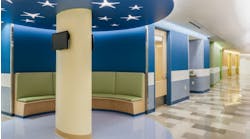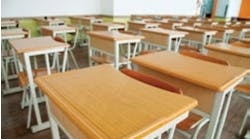One of the keys to providing a high-performance learning environment is creating space where students and instructors can communicate clearly with one another.
But clear classroom communication is jeopardized when a poorly designed space causes echoes, or when unwanted noise interferes with the sounds students and teachers need to hear so that learning can occur.
Poor acoustics is especially detrimental to children. Studies have indicated that excessive background noise and reverberation affect their hearing and comprehension more adversely than adults in similar conditions. In addition, children with hearing impairments, speech impairments or learning disabilities, or those who speak a different language at home may find it more difficult to learn in spaces with distracting noise or echo.
As educators have gained more information about how children learn and what inhibits their comprehension, providing good acoustics in a classroom has become a higher priority.
The 2002 standards developed by the American National Standards Institute and the Acoustical Society of America (ANSI/ASA S12.60-2002) call for an unoccupied classroom background noise level of no greater than 35 decibels and a maximum reverberation time of 0.6 to 0.7 seconds.
Those guidelines are voluntary unless adopted by a governmental entity or other organization. The U.S. Access Board says that several state education departments and individual school districts and higher-education institutions have incorporated the ANSI/ASA standards into their regulations.
Background noise comes from inside an education facility¡ªother classrooms; hallway traffic; heating, ventilation and air conditioning systems¡ªand from outside the school walls¡ªplayground activity, street traffic, airplanes or neighboring businesses. The difference between speech levels and levels of background noise is usually referred to as the signal-to-noise ratio, the guidelines state.
The ANSI/ASA guidelines say that limiting background noise in a classroom to 35 decibels is necessary to achieve what is considered the desired signal-to-noise ratio of at least 15 decibels.
Reverberation time is affected by the shape of a classroom, as well as the materials that fill the space and cover the walls and ceiling.
The reverberation standards also are based on the desired signal-to-noise ratio. "It was assumed that reverberation times of 0.6 seconds or less in small and mid-sized classrooms and 0.7 seconds or less in larger classrooms will not degrade speech intelligibility excessively as long as signal-to-noise ratios of 15 decibels or better are maintained," the standards say.
HVAC systems can generate a lot of noise that can distract learners, so designers and builders should seek quieter equipment and try to install noisier parts of it away from classrooms. Plumbing systems also generate sound that can add to the background noise in a classroom. To minimize the noise, piping should be run above corridor ceilings, not above learning spaces. Bathrooms should be situated away from classrooms. Plumbing systems should be outfitted with cast-iron pipe, if possible.
The type of electrical and lighting equipment installed in a classroom, as well as instructional equipment, also can affect the amount of background noise.

